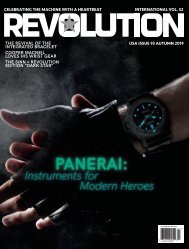REVOLUTION_International_Vol 56
Create successful ePaper yourself
Turn your PDF publications into a flip-book with our unique Google optimized e-Paper software.
The legendary Ref.
1518 (Image: John
Goldberger).
WHY IS THE CH 29 SO AWESOME?
The caliber
CH 29 which
forms the base
caliber of the
Ref. 5270.
1. Optimized Tooth Profile
The first patent relates to an all-new tooth profile for both the
central chronograph wheel and the drive wheel. In previous
movements, these wheels meshed in such a way that the teeth
might not mate precisely which caused chronograph backlash
or the seconds hand to jump forward or backwards in an
unsightly way. Patek eliminated that with its all-new profile
which allows the teeth to slip easily into place even if they
contact point to point.
3. Optimized synchronization of the clutch lever and brake lever
The third patent relates to the eccentric cap on the column
wheel. OK, so to meet Geneva Seal requirements, your column
wheel needs to wear a decorative cap. But leave it to Patek
Philippe’s engineers to transform this into an eccentric element
that actually controls the depth to which the drive wheel and
the chronograph wheel mesh. This is absolute genius as it takes
what was previously a purely decorative element and gives it a
vital function. Bravo, Patek!
5. Hammers pivoted between jewel bearings
The fifth patent has to do with self-adjusting hammers. On
the Lemania 2310, the reset hammers for the minute counter
and the chronograph seconds wheel are one piece. Getting
them to strike their respective heart cams at the same time
is challenging. In the CH 29, the minute reset hammer is
individually sprung and pivots on the seconds hammer. Again,
why no one ever thought about this before is incredible but
leave it to Patek to achieve it.
The unbroken chain of Patek perpetual chronograph
majesty goes as follows: the 1518 (1941–1954), the 2499
(1950–1985), the 3970 (1985–2004), the 5970 (2004-2010)
and then the fantastic 5270 (2004–present day). While the
1518 and the 2499 used the Valjoux base, the 3970 and the 5970
used the Lemania 2310 caliber as their base. But when the 5270
was launched, it had the honor of being the first Patek Philippe
that featured a completely in-house movement. And what a
movement it was! The CH 29 which formed the base caliber
of the 5270 was one of the most advanced and technically
innovative chronograph calibers in existence. It is to my mind
the best thought-out laterally coupled chronograph movement
ever designed, and it featured six patents.
2. Precision adjustment of engagement depth at the column wheel
The second patent relates to the synchronization of the brake
and clutch lever. Basically the brake needs to be off precisely
as the clutch engages and needs to be back on as soon as it
disengages from the chronograph wheel. Previously these
two levers were operated by the column wheel and had to be
adjusted individually, so getting the timing right was extremely
labor-intensive and challenging. In the CH 29 the brake lever
is operated by the arm of the clutch lever. An eccentric screw on
the clutch lever allows Patek’s watchmakers to adjust the depth
of engagement and the timing to perfection.
4. Slotted minute-counter cam
The fourth patent relates to the system for the precise jumping
minute counter. The first watch to feature this type of chrono
counter was the Lange Datograph. However, this watch uses
a system with a snail cam on the chronograph wheel and a
feeler that drops off the end of the cam each time the seconds
hand passes the one-minute mark and drags the minute
counter forward. This can create some amount of friction and
can potentially be a drag on the movement especially when
the torque of the mainspring weakens as it unwinds. Patek
came up with a system with a pierced cam and a much gentler
slope; a system that appears to be aided by a spiral all its own.
A sort of remontoir d’egalité just for the minute counter.
6. Self-setting hammers
Patent six is that these reset hammers are pivoted between
jewels to eliminate friction and bring an ever greater aura of
horological finery to this amazing movement.
Finally, the CH 29 oscillated at the much more stable rate
of 28,800 vibrations per hour versus the CH 27’s 18,000
vibrations per hour.
THE HISTORY OF THE REF. 5270
OK, so now that we understand how amazing the CH 29 is, let’s
look at the history of the ref. 5270. The watch was launched in
2011. And instantly you could see several key differences. First,
the leap-year indicator was no longer coaxial to the minute
20 PRIME TIME
PRIME TIME 21
18-25 USA Prime Time - Patek Philippe 2020 D.indd 20 15/8/20 1:37 AM
RM57539_Issue103_020
075823 Mon, Aug 17, 2020
18-25 USA Prime Time - Patek Philippe 2020 D.indd 21 15/8/20 1:37 AM
RM57539_Issue103_021
075824 Mon, Aug 17, 2020











